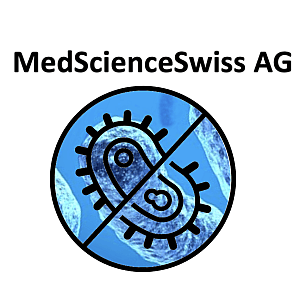- Tuesday, December 3, 2024 @ 12:00 am
MedScienceSwiss is developing a non-pharmaceutical therapy for the treatment of antibiotic-resistant bacteria. The goal: to significantly reduce the number of deaths in hospitals due to nosocomial (difficult-to-treat) infections. The technology is not only intended to serve as an alternative to the current plan A (antibiotics), but also to function as a general approach to the treatment of resistant bacteria in the future.
On December 2, 2024, ChemiExtra published an article about MedScienceSwiss' technology to fight antibiotic-resistant bacteria.
In intensive care units, too many deaths occur due to multi-resistant bacteria. Multi-resistance is increasing every year. Pathogens with multiple resistance to antibiotics (multiresistant pathogens, MRE) are bacteria against which most antibiotics have become ineffective. Overall, there are said to be three million victims of nosocomial infections worldwide. MedScienceSwiss AG is endeavoring to combat these resistances with a new type of therapy.
First, the surface of the bacteria is damaged
Treating bacteria with modulated high-energy electromagnetic fields also makes it possible to eliminate multi-resistant germs. Studies by MedScienceSwiss have shown that the new method damages the surface of the bacteria, leading to their destruction and preventing them from reproducing. Throughout the entire process, human tissue remains unaffected. The researchers assume that the bacterial membrane component (peptidoglycan), which does not occur in the human body, is involved in this process.
Since the use of electromagnetic fields does not require chemicals and toxic compounds, the Zurich researchers' method opens up a new way to treat nosocomial infections without the addition of antibiotics or other chemical substances. In contrast to the pharmaceutical approach, pathogens cannot develop resistance to the electromagnetic fields. Consequently, any treatment is more effective, free of side effects and cheaper than the antibiotic approach. In the future, the therapy is to be used in both industrialized and developing countries. An additional advantage of the “Plan B” technology is that existing MRI rooms and personnel can be used to operate the required equipment.
Problems associated with the pharmaceutical approach – such as interruptions in the cold chain or production bottlenecks – are irrelevant for the devices and methods of MedScienceSwiss. The modulated high-energy fields are able to penetrate all types of tissue (muscular, adipose, brain and connective tissue) as well as blood. Likewise, biofilms of any thickness. Studies by the researchers have already shown that gender does not play a role in the procedure known as “Plan B”. There was no gender specificity in the use of models with healthy female mammary gland cells and healthy male bronchial cells.
The tests were not only evaluated using fluorescence microscopy, but also with the FDA-certified devices from Thermofisher with corresponding tests for membrane integrity and cell metabolism. The results are certified and show no change compared to the control cells. This means that the human cells are not damaged by the treatment with the electromagnetic fields, although the disease-causing bacteria are eliminated at the same time. In order to be market-ready, animal experiments are still necessary for application to patients. However, their number can be reduced if models for biofilms are used.
Using fluorescence to determine viability
A study of the tolerance of electromagnetic fields on human breast epithelial cells (HMEpiC) and human bronchial epithelial cells (HBEpiC) showed that they did not suffer any loss of vitality. The evaluation was carried out using fluorescence microscopy and viability tests with the microplate assay “Prestoblue” and the “Live/Dead Viability/Cytotoxicity” assay kit. This is a two-color fluorescence assay that simultaneously identifies living and dead cells.
The treated bronchial and mammillary cells show no increased loss of viability compared to untreated control cells. Damaged and non-viable cells have lower inherent metabolic activity and therefore produce a proportionally lower signal than healthy cells.
Resonance pattern database
MedScienceSwiss creates a database of mechanically induced resonances for each characterized bacterial strain. It has been shown that each germ requires a different electromagnetic field tailored to its resonance and is therefore very specific. MedScienceSwiss' current catalog contains the most dangerous bacterial strains, including:
- Klebsiella pneumoniae ESBL neg and pos.
- Staphylococcus aureus MRSA (various subgroups )
- Pseudomonas aeruginosa ATCC
- Escherichia coli ATCC (various subgroups )
- Salmonella
- Acinetobacter baumannii
- Propionium acne
The company, founded in 2020, will conduct the experiments on the biofilm model and the required animal experiments in the course of 2025. The development of the power electronics is also well advanced, and approval will be sought afterwards.
